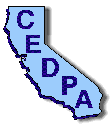
 |
California Educational Data Processing Association |
The DataBus - Vol. 36, No. 5
|
Editor's Note: The last issue of The DataBus included an article by CEDPA director Terrell Tucker about his experiences with Spread Spectrum radios. Allen D. Hall, Vice President of Advanced Data Support Systems, Inc., an integrator that provides Spread Spectrum solutions, has agreed to provide additional information about the technology in general and Panama-Buena Vista Union School District's experiences in particular.
Advanced Data Support Systems, Inc. (ADSS) appreciates the opportunity to respond to questions raised and clarification of some issues as presented in the last CEDPA Databus issue regarding "Spread Spectrum Wireless vs. ISDN, Part I" submitted by Terrell Tucker of the Panama-Buena Vista Union School District (PBVUSD), the views expressed by Mr. Tucker were his own personal statements. Our firm was the integrator of the wireless link established between their Leo B. Hart Elementary School and the district office to facilitate the WAN objectives desired by PBVUSD. ADSS has also been working with their district for over five years in the implementation of classroom technology via campus-wide LAN networks (fiber and copper based).
ADSS was peripherally involved in the WAN system proposed by Pacific Bell, and, we assisted the district in the connection of the first link from their Technology Training Center to the district office. Based on performance issues encountered during the first four months of the ISDN based WAN system, alternative ideas were discussed to improve the speed and performance desired by the district in meeting the long-term goals established by their district. ADSS responded with wireless spread spectrum products manufactured by Solectek Corporation of San Diego, CA.
Solectek specializes in long-distance outdoor certified wireless products (bridges and routers) ranging up to 25 miles distance between sites. Solectek offers complete FCC certified products as total systems - including outdoor antennas, cabling and programmable interface devices (some other resellers have used indoor based roaming and/or bridging products and use third-party outdoor antennas and cables supplied by the installer that have not typically been certified as a total system). The link installed between Hart School and the District Office was the Solectek AIRLAN/Bridge Plus 914 Mhz Wireless Bridge that has a range of 3 to 5 miles in a point-to-point installation (directional antenna to directional antenna), adequate for the PBVUSD initial test requirement - but, a range of approximately 1/2 to 1 mile in an omni-directional environment (not feasible for the complete PBVUSD long term requirements). A better long-term solution is best suited to the Solectek AIRLAN/Bridge Ultra, a 2.4 Ghz Wireless Bridge capable of operations up to 25 miles using directional antennas and 3 to 5 miles in an omni-directional environment from their district office. It was decided by ADSS and PBVUSD that the lower cost (not low level) AIRLAN/Bridge Plus would be used by the District in the wireless test - which has performed to expections, as stated by PBVUSD with regards to performance.
Concurrently, while ADSS was installing the PBVUSD point-to-point link, ADSS was also installing a district-wide WAN wireless link for the Greenfield Union School District (9 school sites linked into the District Office) using the Solectek AIRLAN/Bridge Ultra 2.4 Ghz Wireless Bridge products. Based on their districts requirement for peer-to-peer operations, Solectek modified the base software of the AIRLAN/Bridge Ultra to incorporate portions of the CISCO IOS software used in the AIRLAN/Router products to incorporate the peer-to-peer requirements, and, was also able to solve the inherent problem of the CSMA/CA used in Ethernet based wireless links (analogous to the CSMA/CD protocol used in wired Ethernet networks) when used in a multi-site with directional antennas to a central site with omni-directional antennas. Refer to the Solectek White Paper article on Solectek's Wireless Multipoint Media Access Control Protocol for a more in depth discussion regarding the CSMA/CA protocol used by virtually all wireless bridge products - not just a Solectek problem (internet address is http://www.solectek.com). The new product now offered by Solectek is the AIRLAN/Bridge 200 that incorporates these new features (while still offering the original CSMA/CA protocol - user selectable). One of the benefits of using a programmable bridging product is that changes can be incorporated by changing the software without re-engineering or changing ROM chips used in a bounded "box" solution, however, costs are also higher when using computer based programmable devices.
Wireless communications is an interesting market and is able address some problems associated with land-based communication systems-who knows what the future has in store for us all? Comments and questions regarding this article may be addressed to Allen Hall at Advanced Data Support Systems, Inc. in Bakersfield, CA (E-MAIL address is: [email protected]).